How To Build A Raised Garden Bed On A Slope
Hi guys,
If you've followed us long enough, you might note that this is the third iteration of raised beds. At our first house, almost 10 years ago we made one giant raised bed which worked just fine but wasn't super practical when it came to actually working on the garden. Because of the large size, you had to physically get into the garden to do anything but water it. (READ MORE about our V1 Garden)
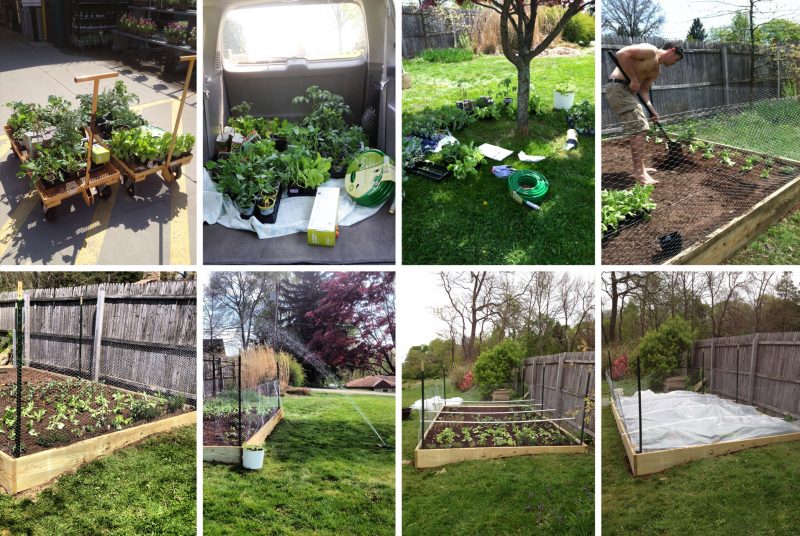
At our previous house, my dad helped us make beautiful raised beds with a combination of wood and corrugated steel paneling. These V2 beds were vastly improved in that they were appropriately sized. Each bed was 4 feet wide and 8 feet long, which allows you to reach into the full depth of the garden from the sides. Provided you have access on all sides, it works great. We learned how to extend the growing season by adding cold frames to these beds. Sometimes I miss them, because they were beautiful and grew awesome plants. (READ MORE about our V2 Gardens)
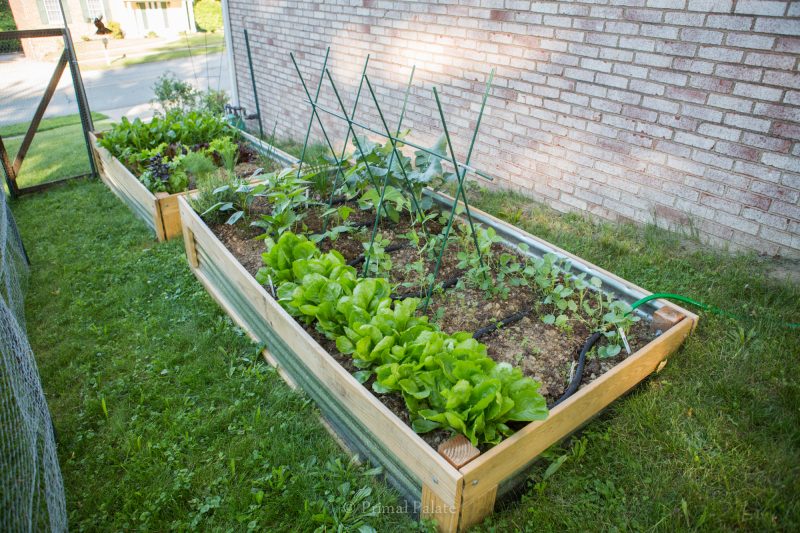
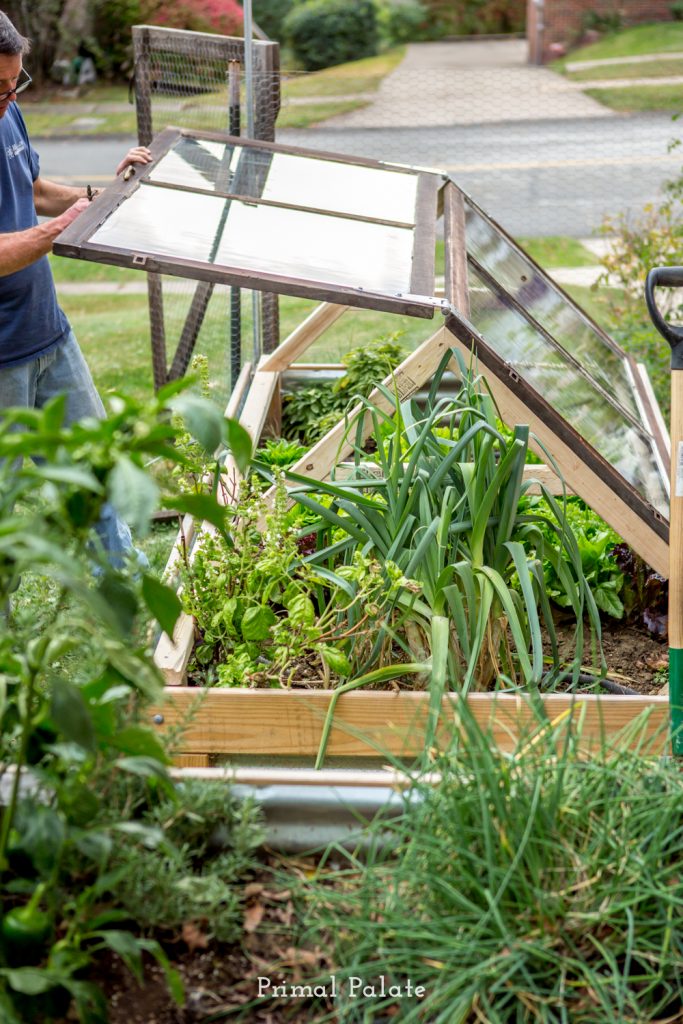
When we moved into our new home, we had a huge array of projects that required our attention inside. So in our first year in the house, we did a lot of indoor renovations and also cleaned up the gardens around the house itself. We've now been in the house for a year and a half, and it finally felt like time to start our vegetable garden. Truth be told, the current pandemic also played a big role in getting us off our butts to start this project. With a little extra time on our hands and an added incentive to have a degree of control over our food supply, we started planning.
It wasn't until we found this photo on Pinterest that our design aesthetic came into focus.
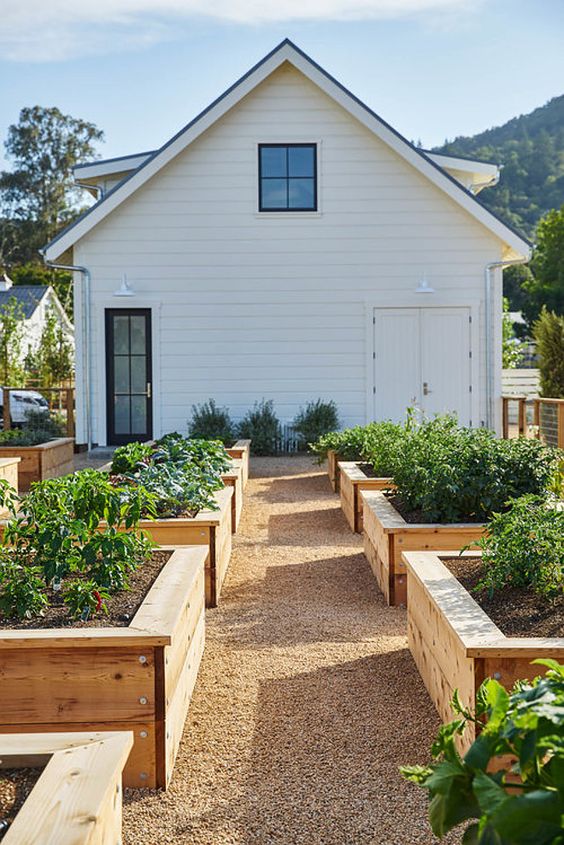
From there, we went out into the yard and discussed site selection. There were a couple spots we identified as possibilities, but ultimately a sunny spot in our lower yard won. It's a gently sloping grassy area, getting about 5-7 hours of sun per day, that can easily accommodate expanding plans should the need arise. More sun would be better, but we live in a heavily wooded area, and this was one of the best spots in our yard.
We decided to create four beds in a symmetrical layout, each being 4′ x 6′ – which I knew from past experience was a good size. 4′ x 8′ would have been fine too, but that increase of 2 feet meant more money on wood, more soil, more digging, and more work. So I opted for the smaller layout, knowing we could add more beds someday if needed.
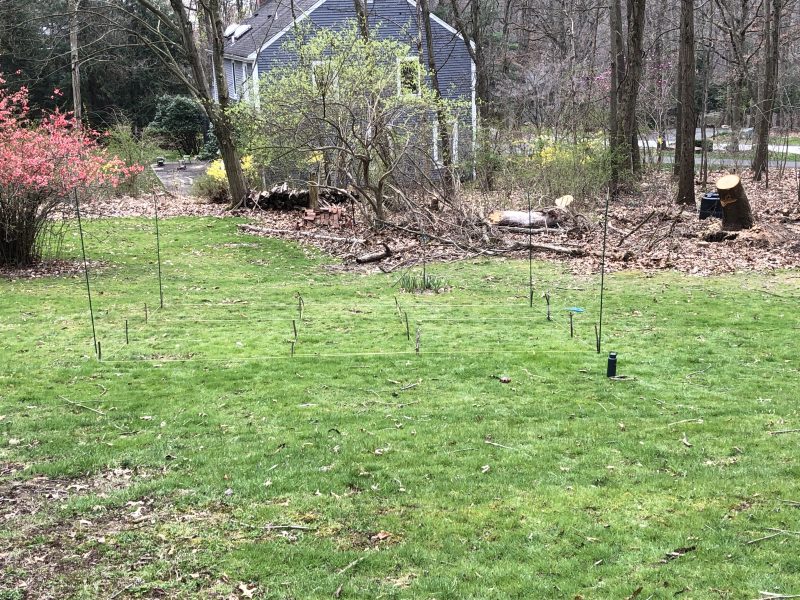
Site and layout had been decided, so the next day I went out to the spot and started laying out the garden using a string line. I found this helpful, as I wanted to align the beds in a specific orientation to our house and the street (basically aligned to the same grid). With string lines set up, I could not only step back and look to see if it looked right, but I was also able to take measurements from our driveway, which let me determine if the beds were parallel or not. If this sounds overboard, it gets better.
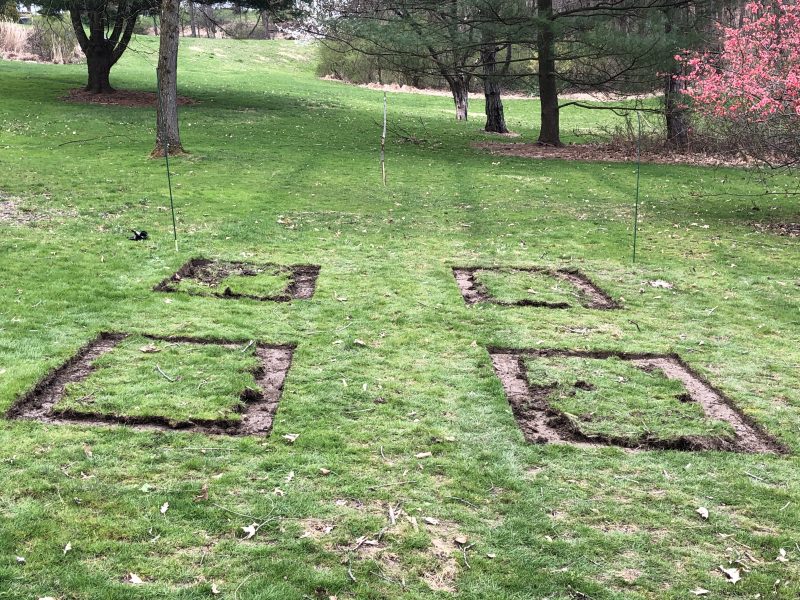
I used a square garden spade, my layout weapon of choice, to carefully cut out the bed outlines and remove the grass for about a shovel width. This allowed for a second check of measurements and alignment. You know the saying measure twice, cut once? It's okay if you measure a lot more than twice.
With the concept photo and dimensions in hand, I put together a lumber order from a nearby big box hardware store. I'm grateful that these guys were still taking and delivering orders: which seemed to be the best way to do it under the current shelter in place order. While I didn't get to hand pick the lumber (resulting in some creative layout choices), I'm so glad to have been able to place the order online and have it delivered a few days later.
I'm going to show our exact supply list and design drawings, etc… but first a caveat. If you want to make raised beds similar to these, you can pick a flat site and get away with doing them one board high instead of 2. I did 2 boards high to accommodate the cross slope. If you have a flat yard, I would suggest framing out a 4×6 bed with 2×10 or 2×12 and calling it a day. You'll be much happier and spend a lot less time digging. However if you have a site with a slope and want to make these exactly like ours, here's the list of supplies you'll want.
*With lumber selection, I ordered an extra board for each size so that I had the ability to select if one turned out to be really bad, which was a good thing. Even though some of the boards were real duds, I was able to allocate those to parts of construction that were at or below grade.
*All lumber used is untreated pine.
Raw Materials
- (13 boards) 2-in x 12-in x 12-ft Pine Lumber (Common); 1.5-in x 11.25-in x 12-ft (Actual)
- (10 pieces) 2-in x 4-in x 8-ft Spruce Pine Fir (Common); 1.5-in x 3.5-in x 8-ft (Actual)
- (11 boards) 2-in x 8-in x 12-ft Southern Yellow Pine Lumber (Common); 1.5-in x 7.25-in x 12-ft (Actual)
- 300 ct bucket of countersinking wood screws.
- Plus I ordered deer fencing at that time, as well as fresh saw blades which didn't actually come in time.
- 6 yards of premium topsoil / compost mix.
- We also used some fine crushed limestone gravel from our driveway under the boards for better drainage. Optional.
Total materials cost was about $225 per raised bed, delivered. I'm certain that with some creativity you can do it for less.
Tools & Supplies
- Wheelbarrow
- Square spade
- Round point shovel
- String line and string level
- Tape measure
- 2′ level (or longer)
- Mallet / hammer
- Combination square or carpenter's square
- Speed Square with 45 degree angle
- Circular Saw
- Sawhorses
- Pencil
- Earplugs
- Mask
- Eye protection
- Gloves
- Axe (if digging in an area with roots)
- Rake
- Cordless drill
Seems like a long list, but luckily these are fairly common tools in a well equipped DIY arsenal. The trickiest part of this project is running a circular saw on the 45 degree cuts for the seat rail. Overall, its pretty standard construction. I chose to make the beds dimensionally 1″ shorter than 4×6 because I knew with the irregularities of digging the footings, allowing for inaccurate digging would make the beds easier to place.
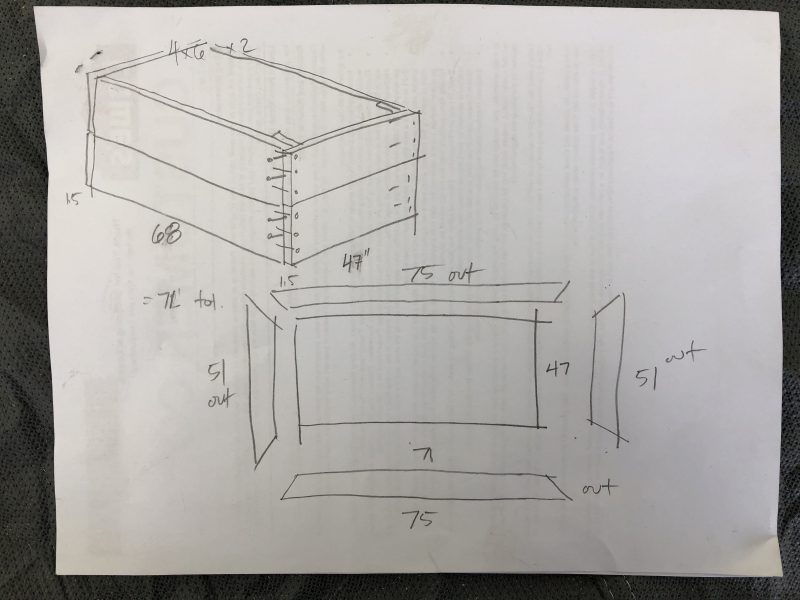
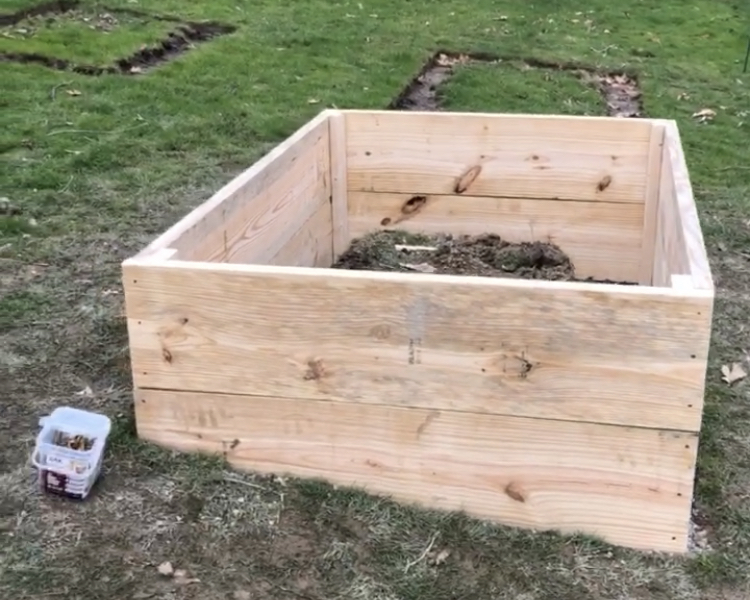
(Sorry for the bad photo – its a capture from a video). This photo shows some of the box construction, before adding the soil and the cap).
This is my rough construction drawing with key dimensions in inches. The beds are 2 boards high of 2 x 12, with the short side facing forward and having a full board width for the short side. The long dimension fits between the end caps. 2×4's help attach the top and bottom courses at the corners. The bottom drawing shows the cap / seat rail. We decided on a 2″ overhang for the seat rail (made with 2×8's), which gave us the outside dimensions of the miter cut boards. Along with the speed square, this gave a quick way to lay out and cut the seat rail boards.
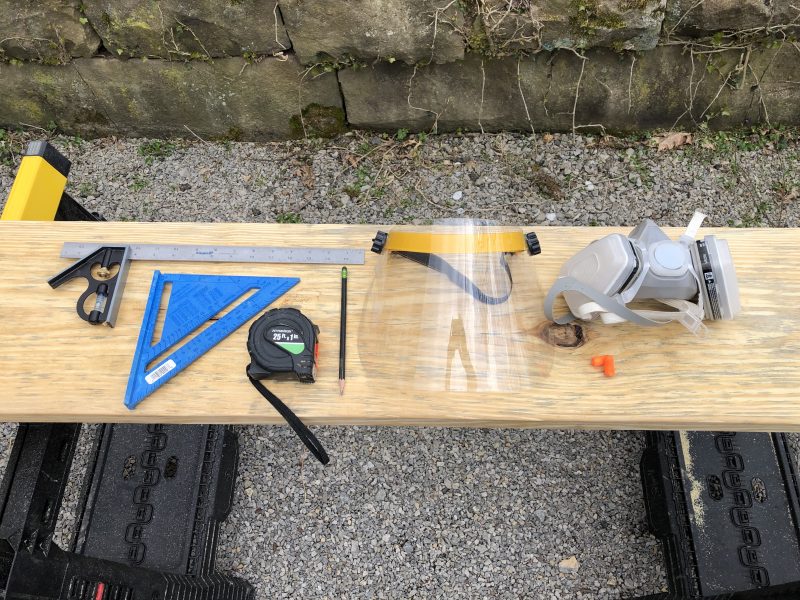
Construction Process:
- Dig out footing to approximate level
- Check for level (if level, proceed)
- Thin layer of gravel in footing for better drainage
- Cut 2×12 boards for bottom course (2 @ 47″, 2 @ 68″)
- Assemble bottom layer
- Check for level on bottom later, Check corners and cross measurements for square
- Cut upper course boards, Cut 2×4's to 22.5″ for framing the corners.
- Attach the long boards to the 2×4's at the corners, top course first, then bottom.
- Attach end boards (47″ boards) to frame
- Fill bed with soil
- Cut and attach seat rail boards.
Rinse and repeat for additional beds.
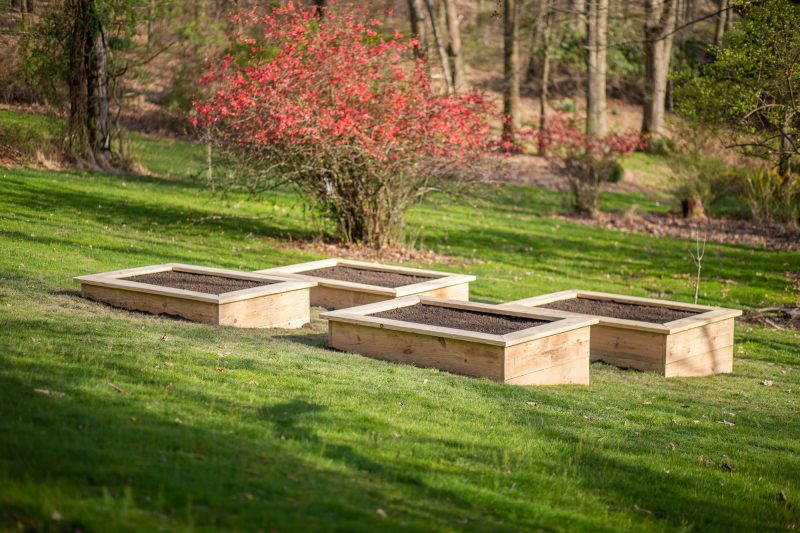
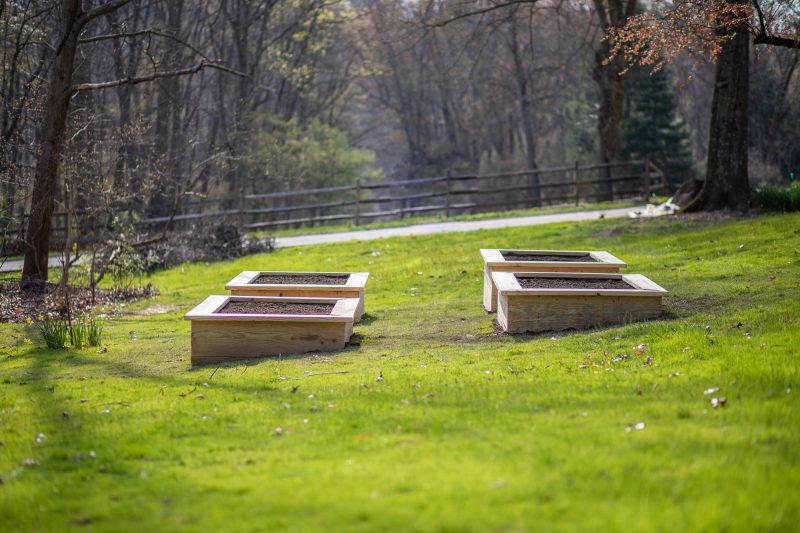
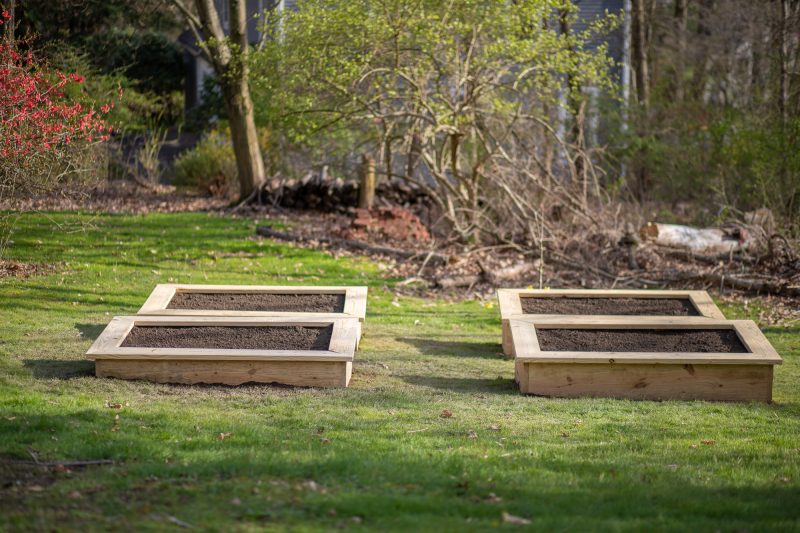
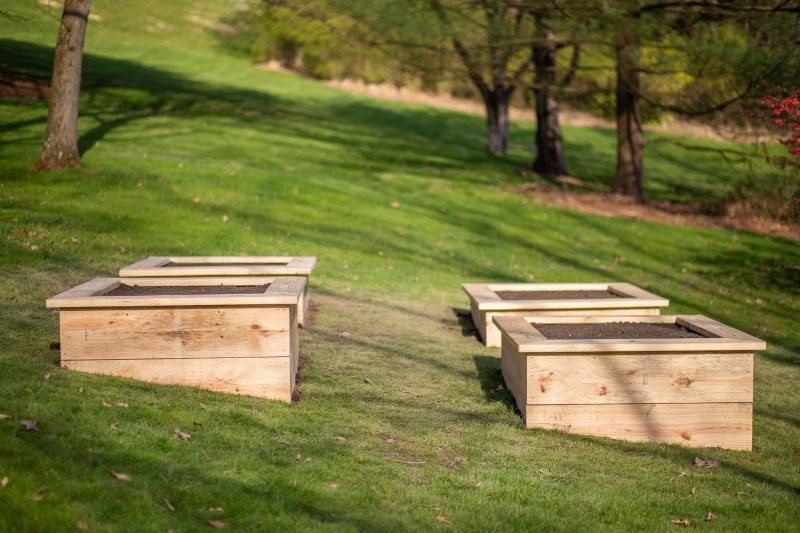
I'm so pleased with how the beds turned out. Naturally the real fun begins when we get to plant them and eat the fruits of our labor. But the design and construction is the fundamental work of building something that will last and be enjoyed for years to come. Every time I look out the window at the beds, I wanted to be proud of the work that I did. The last two vegetable gardens we had were not in a sight line from the house, so building these well was particularly important to me.
I'll update this post with photos of them planted when we are rolling with produce later this spring. If you have any questions about the build you can TEXT them to me (412-459-7688) or drop them the the comments below. You can also reach out on social media, or send me a letter (kidding!) – but I am happy to help answer your gardening and raised bed building questions. Hope this post was helpful! Good luck!
Bill
How To Build A Raised Garden Bed On A Slope
Source: https://www.primalpalate.com/paleo-blog/how-to-build-raised-garden-beds-on-a-slope/
Posted by: huttonlecoany.blogspot.com

0 Response to "How To Build A Raised Garden Bed On A Slope"
Post a Comment